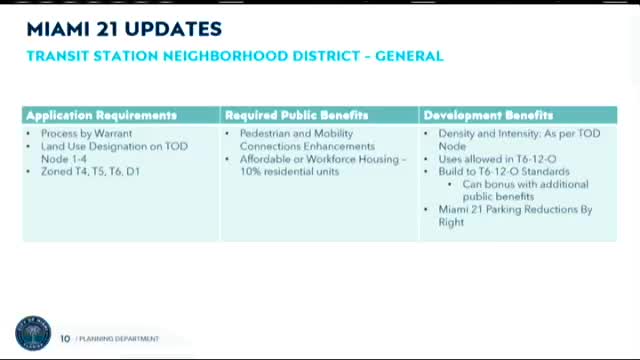Miami Dade unveils Transit-Oriented Development programs for mixed-use housing
June 18, 2025 | Miami, Miami-Dade County, Florida
Thanks to Republi.us and Family Scribe , all articles about Florida are free for you to enjoy throughout 2025!

This article was created by AI using a video recording of the meeting. It summarizes the key points discussed, but for full details and context, please refer to the video of the full meeting. Link to Full Meeting
To qualify for these programs, properties must possess a specific Land Use Designation of Transit-Oriented Development (TOD) nodes 1 through 4. This designation is crucial as it aligns with the city’s future land use plan and is tied to the approval of fixed rail stations by the Miami-Dade Transportation Planning Organization. Properties designated as T3 are notably excluded from eligibility, emphasizing a shift towards higher-density zoning classifications such as T4, T5, T6, and D1.
A significant aspect of the general district is the requirement for public benefits, which are not optional. Developers must enhance pedestrian and mobility connections, which could include crosswalks, bike lanes, and improved streetscapes. Additionally, at least 10% of the units in any new development must be designated as affordable or workforce housing, ensuring that the benefits of urban growth are shared with the community.
The enhanced district program introduces a more comprehensive master planning approach, requiring developers to submit detailed diagrams and studies as part of their applications. This includes open space diagrams, traffic analyses, and a public benefits summary. Notably, the minimum lot size for applications has been increased from 40,000 square feet to 3 acres, encouraging developers to create cohesive neighborhoods rather than isolated projects.
Public benefits in the enhanced district are substantial, with developers required to either construct new train stations or improve existing ones, representing a significant investment of approximately $35 to $40 million. Furthermore, 20% of units must be affordable or workforce housing, and enhanced landscaping with mature trees is mandated to promote a sustainable urban environment.
The board also emphasized the importance of community engagement, stating that public hearings will be held to review plans and gather feedback from local residents. This approach aims to ensure that developments align with community needs and aspirations.
As Miami continues to grow, these new districts represent a strategic effort to balance urban development with community welfare, setting a precedent for future projects in the city. The implications of these changes will likely resonate throughout the community, shaping the urban fabric of Miami for years to come.
Converted from City of Miami, FL - Planning, Zoning, and Appeals Board - Jun 18, 2025 meeting on June 18, 2025
Link to Full Meeting
Comments
View full meeting
This article is based on a recent meeting—watch the full video and explore the complete transcript for deeper insights into the discussion.
View full meeting